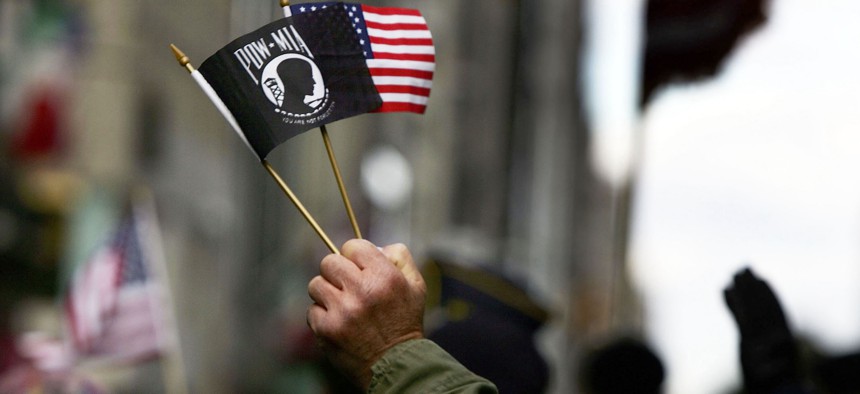In Great Power Wars, Americans Could Again Become POWs
After years of training for counterinsurgency, today’s soldiers need to know how to survive large-scale warfare.
With the return of great power competition comes another renewed threat most of us probably have not thought about in a long time: American soldiers could become prisoners of war.
To put it in perspective, the last conflict where America suffered hundreds of POWs was the Vietnam War. Today, after two decades of fighting non-state insurgents, Survival, Evasion, Resistance, and Escape, or SERE, training for U.S. service members has been tailored to match the counterinsurgency operational environment. But in a large-scale conflict between peer countries, aircrews bail out over enemy-controlled territory, wounded soldiers are captured by an advancing enemy, logistic convoys are ambushed, and the turmoil that comes with a moving battlefield creates risk for troops being captured by the enemy. If that is the more likely battlespace of the future, then there is a need to change once again how we prepare soldiers for being captured.
A future fight with a peer or near-peer adversary will likely be a rapidly unfolding event via a fait accompli attack in which an rapidly advancing enemy could overrun U.S. forces and any additional rapid response forces. According to the U.S. Army, a “fait accompli attack is intended to achieve military and political objectives rapidly and then to quickly consolidate those gains so that any attempt to reverse the action by the [United States] would entail unacceptable cost and risk.” The attack would occur via a rapid adversarial advancement to gain as much terrain and bargaining power before the U.S. military could send major formations of troops from continental U.S. bases. The most likely scenario where this would occur is in Europe along NATO’s eastern front, but there are several scenarios where this also could occur in the Indo-Pacific region. Here’s how.
All major powers envision potential future wars as highly mobile and offensive actions, coupled with pursuing deep strikes into enemy territory to break opposing defenses. In the U.S. concept of multi-domain operations, the military seeks to penetrate defenses, dis-integrate the enemy, and exploit the resultant freedom of movement to achieve its operational and strategic goals. Two confronting forces with similar offensive multi-domain doctrines will create a battle that has velocity in the execution, mobility, and an absence of traditional frontlines as the fight occurs over the whole surface of the operational area. In a fluid, rapid, and violent battlefield of scale there will be numerous situations where further resistance will result in certain death — becoming a POW is the only option.
It's a rational decision that troops should be taught, but the context of surrender is essential. If you no longer have the means to resist on the battlefield and capture is the only option, you have met your obligation and now have the ability to continue the fight as a POW vs. combatant in the war.
In his Joint Forces Quarterly article “Detention Operations as a Strategic Consideration,” U.S. Army Maj. Gen. John Hussey, commanding general of the 200th Military Police Command, explains potential challenges to the United States and allies in capturing large numbers of detainees. What is not considered is that in great power competition, the inverse is also probable: thousands of American Soldiers could become POWs during the wars of the 21st century. Depending upon the adversary, it is also likely that many POW or missing in action soldiers would die or be killed as captives due to potential adversaries’ lack of respect for international law and human rights.
During the Cold War, U.S. and Allied forces trained their troops to consider and prepare for the contingency that they would become a POW. Years of counterinsurgency operations has bred complacency, the notion that potentially thousands, of soldiers could become POWs is no longer considered ,and thus preparing soldiers has also lapsed.
Training for the event of being captured serves several purposes. A mentally prepared soldier is less likely to be shocked or act irrational at the point of capture, but instead seek to protect themself, their fellow soldiers, and critical information. The first hour after capture is key for an adversary to extract tactical information from captured POWs because the information is still relevant and the POW can be in shock. Such a mental state makes a POW vulnerable to being influenced by their captors. It is also essential that a soldier clearly understand their rights as POWs according to international laws, while simultaneously understanding that several of our potential adversaries do not respect those same governing laws.
We can only hope to mentally prepare and adequately train U.S. soldiers to handle becoming POWs if we first consider the likelihood that they could become POWs.
Jan Kallberg is a scientist at the Army Cyber Institute at West Point, managing editor of the Cyber Defense Review, and an assistant professor at the U.S. Military Academy. Lt. Col. Todd Arnold is a research scientist in the Army Cyber Institute at West Point and assistant professor in U.S. Military Academy’s Department of Electrical Engineering and Computer Science, or EECS. The views expressed are those of the authors and do not reflect the official policy or position of the Army Cyber Institute at West Point, the U.S. Military Academy, or the Department of Defense.
NEXT STORY: War is Changing. So Should the Pentagon’s Budget




